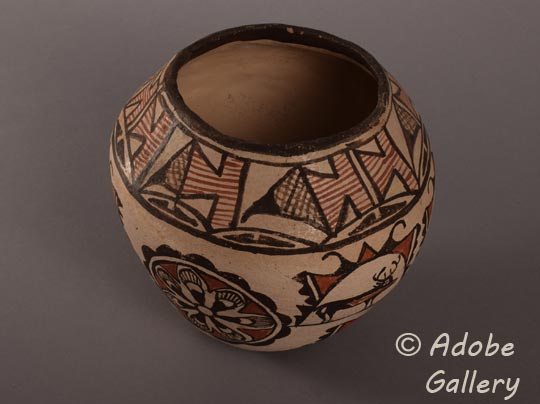Zuni Pueblo Small Historic Pottery Jar with Heartline Deer and Rosettes [SOLD]
+ Add to my watchlist Forward to Friend
- Category: Historic
- Origin: Zuni Pueblo, SHE-WE-NA
- Medium: clay, pigment
- Size:
8-½” height x 8-½” width - Item # C4803G SOLD
Pottery is one of the most celebrated traditions at Zuni Pueblo, having been made there for at least 1,000 years. Many different shapes and functions have been applied to these storied pots, but for most of them, there is something distinctly Zuni in their design patterns. This jar is no exception.
The bottom of the jar is completely flat, and the jar is made up of a slender body which expands slightly from the base. The central theme of the jar is heartline deer, as there are six in total, three on either side. On this jar, there are three rows of patterns. The bottom contains one larger heartline deer, the middle two smaller heartline deer, and the top neck bank features customary Zuni symbols. Alongside the deer taking up both the bottom and middle bands are two large rosettes. The coloring of this piece is a standard dark brown and orange over a beige slip.
The most associated design today to Zuni pottery is the heartline deer. It has been used constantly since the beginning of the 20th century, although it had been used previously, as early as 1840 on Kiapkwa polychrome. Although it is always referred to as heartline deer, some representations appear to be antelope and elk. The design consists of a red line from the mouth of the animal to the heart. It has been defined as the sacred breath of life of the animal. Zuni feather motifs are generally used to form an arch or a "house" over the deer.
What is the arrow that points into the deer's body? That is a special kind of arrow called a "heartline." It is a symbol. It reminds us of the deer's life forces and the spiritual connections between animals and humans. It also represents the sacred act of hunting the deer. For use in religious ceremonies, especially ceremonies asking .... the gods for rain. These were especially important ceremonies for the pueblo peoples because rain is scarce in their ancestral lands. - University of Iowa Stanley Museum of Art (see the YouTube video we recommended)
Rosettes or flowers in a circular pattern are typically used on the body of the jar as dividers between deer designs. The neck design on Zuni jars is usually different in style from the body design.
There has been a repair on this piece which can be seen under a blacklight. The rim has had some restoration and overpaint, although in regular lighting this is barely visible. It can be felt to the touch if one feels for it.
This small jar appears to date to the early 20th century and was quite possibly made as an item to sell to eager visitors looking to capture a piece of Zuni Pueblo. That a jar was made for sale rather than for use does not make it any less special, as the processes for making either are identical. Additionally, there does happen to be a charm to small pottery vessels that has the propensity to get lost in larger size ones. Perhaps it is our association with small children and small animals that attracts our attention.
Condition: fairly good condition although a blacklight shows there has been a repair to the rim and overpaint on that spot
Provenance: this Zuni Pueblo Small Historic Pottery Jar with Heartline Deer and Rosettes is from a client of Adobe Gallery
Recommended Reading: The Pottery of Zuni Pueblo by Lanmon and Harlow, 2008. Museum of New Mexico Press
TAGS: puki depression, pottery, Zuni Pueblo, old pottery

- Category: Historic
- Origin: Zuni Pueblo, SHE-WE-NA
- Medium: clay, pigment
- Size:
8-½” height x 8-½” width - Item # C4803G SOLD
Adobe Gallery Recommended Reading
Adobe Gallery Recommended Items
If you are interested in this item, we would also like to recommend these other related items:



